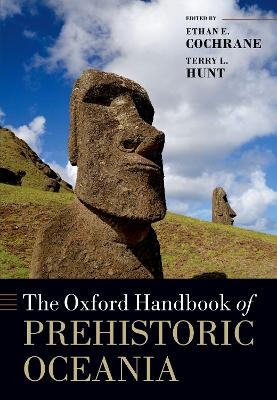
The Oxford Handbook of Prehistoric Oceania
Oxford University Press Inc (Verlag)
978-0-19-761076-3 (ISBN)
Oceania was the last region on earth to be permanently inhabited, with the final settlers reaching Aotearoa/New Zealand approximately AD 1300. This is about the same time that related Polynesian populations began erecting Easter Island's gigantic statues, farming the valley slopes of Tahiti and similar islands, and moving finely made basalt tools over several thousand kilometers of open ocean between Hawai'i, the Marquesas, the Cook Islands, and archipelagos in between.
The remarkable prehistory of Polynesia is one chapter of Oceania's human story.
Almost 50,000 years prior, people entered Oceania for the first time, arriving in New Guinea and its northern offshore islands shortly thereafter, a biogeographic region labelled Near Oceania and including parts of Melanesia. Near Oceania saw the independent development of agriculture and has a complex history resulting in the greatest linguistic diversity in the world. Beginning 1000 BC, after millennia of gradually accelerating cultural change in Near Oceania, some groups sailed east from this space of inter-visible islands and entered Remote Oceania, rapidly colonizing the widely separated separated archipelagos from Vanuatu to SAmoa with purposeful, return voyages, and carrying an intricately decorated pottery called Lapita. From this common cultural foundation these populations developed separate, but occasionally connected, cultural traditions over the next 3000 years. Western Micronesia, the archipelagos of Palau, Guam and the Marianas, was also colonized around 1500 BC by canoes arriving from the west, beginning equally long sequences of increasingly complex social formations, exchange relationships and monumental constructions.
All of these topics and others are presented in The Oxford Handbook of Prehistoric Oceania, written by Oceania's leading archaeologists and allied researchers. Chapters describe the cultural sequences of the region's major island groups, provide the most recent explanations for diversity and change in Oceanic prehistory, and lay the foundation for the next generation of research.
Ethan E. Cochrane is Associate Professor in Anthropology at the University of Auckland. Terry L. Hunt is Professor in the School of Anthropology and Dean of the Honors College at the University of Arizona.
Chapter 1: The Archaeology of Prehistoric Oceania, Ethan E. Cochrane and Terry L. Hunt
Chapter 2: The Peopling of Sahul and Near Oceania, Sue O'Connor and Peter Hiscock
Chapter 3: The "Austronesian" Dispersal in Island Southeast Asia: Steps toward an Integrated Archaeological Perspective, Tim Denham
Chapter 4: New Guinea, Peter White
Chapter 5: Research Issues in the Circum-New Guinea Islands, J. Specht
Chapter 6: Understanding Lapita as History, John Edward Terrell
Chapter 7: The Chronology of Colonization in Remote Oceania, Timothy Rieth and Ethan E Cochrane
Chapter 8: The Archaeology of Vanuatu: 3,000 Year of History across Islands of Ash and Coral, Stuart Bedford and Matthew Spriggs
Chapter 9: Archaeology of a Piece of Gondwanaland: The Past of New Caledonia, Christophe Sand
Chapter 10: Fiji: Ancient Melting Pot of the Pacific, Ethan E. Cochrane
Chapter 11: Tonga and S?moa in Pacific Prehistory: Contemporary Debates and Personal Perspectives, David B. Burley and David J. Addison
Chapter 12: The Archaeology of Western Micronesia, Scott M. Fitzpatrick
Chapter 13: Archaeology of the Eastern Caroline Islands, Micronesia, J. Stephen Athens
Chapter 14: Linguistic Evidence as a Window in the Prehistory of Oceania, Andrew Pawley
Chapter 15: Coastal Landforms on Islands of Pacific Oceania, William R. Dickinson
Chapter 16: Colonization, Settlement, and Process in Central Eastern Polynesia, Jennifer G. Kahn
Chapter 17: The Prehistory of Hawai'i, Patrick V. Kirch
Chapter 18: The Prehistory of South Polynesia, Atholl Anderson
Chapter 20: The Archaeology of Rapa Nui (Easter Island), Terry L. Hunt and Carl Lipo
Chapter 21: Settlement Pattern Studies in Polynesia: Past Projects, Current Progress, and Future Prospects, Alexander E. Morrison and John T. O'Connor
Chapter 22: Seafaring in Remote Oceania: Traditionalism and Beyond in Maritime Technology and Migration, Atholl Anderson
| Erscheinungsdatum | 06.09.2021 |
|---|---|
| Reihe/Serie | Oxford Handbooks |
| Verlagsort | New York |
| Sprache | englisch |
| Maße | 244 x 173 mm |
| Gewicht | 885 g |
| Themenwelt | Sachbuch/Ratgeber ► Geschichte / Politik ► Vor- und Frühgeschichte / Antike |
| Geisteswissenschaften ► Archäologie | |
| Geschichte ► Allgemeine Geschichte ► Vor- und Frühgeschichte | |
| ISBN-10 | 0-19-761076-5 / 0197610765 |
| ISBN-13 | 978-0-19-761076-3 / 9780197610763 |
| Zustand | Neuware |
| Informationen gemäß Produktsicherheitsverordnung (GPSR) | |
| Haben Sie eine Frage zum Produkt? |
aus dem Bereich


